By Frank Close
Oxford University Press
Hardback: £9.99
“Of all the things that make the universe, the commonest and weirdest are neutrinos.” Thus starts Frank Close’s latest book, Neutrino, a fascinating look into one of the most compelling and surprising scientific advances of the past century.

With its very basic title, a reader might imagine that this book, written by a leading particle theorist, would be an accurate but dry discourse on the eponymous particle. They would be surprised to find a moving book centred on the lives and work of three individuals: Ray Davis, John Bahcall and Bruno Pontecorvo. Neutrino manages to capture not only their impressive scientific contributions but something of their personalities and the times, through an excellent choice of quotes and stories from friends and colleagues. Consequently it is a book that is brief, scientifically accurate and full of drama.
The neutrino’s origins in the early 20th century studies of radiation, stellar astrophysics and neutrino oscillations are all carefully and clearly explained. This book fills in many of the gaps left by more cursory treatments, in particular the road from Wolfgang Pauli’s proposal of the neutrino to the development of the theory of beta decay by Enrico Fermi. But the pedagogic scope is wisely limited and the author does not shy away from leaving the scientific explanations to a footnote if they are incidental to the main storyline.
Neutrino also manages to capture the full spectrum of ideas, events and relationships that play a part in particle physics. The path between brilliant theoretical insight and triumphant experimental verification can be long and precarious. The prosaic (and often deciding) factors – the casual encounter with a colleague that sparks a new idea, incorrect theoretical assumptions identified and corrected, incremental advances in technology, site selection, the vagaries of funding decisions, politics, the role of industrial partners, and just plain luck – are accurately and entertainingly discussed.
That this book succeeds on a number of levels is a credit to the author’s deep knowledge of the physics and his meticulous research, as well as a concise and imaginative writing style. The omission of the LSND and MiniBooNE experiments is the only notable absence, though hardly surprising since the experimental situation here is far from resolved. If the signatures of antineutrino appearance from these experiments stand up to further investigation, neutrinos will have proved to be even weirder than we thought and will provide the author with rich material for a second edition.







